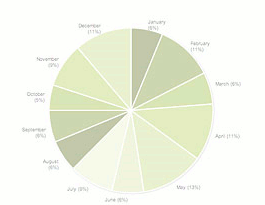


Cornelia I Bargmann Featured in New York Times
Hi friends of women in science,
Women in science are often written up in articles on women in science, less often in articles about first rate science per se. So the article this week entitled, "In Tiny Worm, Unlocking the Secrets of the Brain" by Nicholas Wade in the NYT, about the work of Cornelia I Bargmann, was very welcome. Sonia Pressman Fuentes alerted me to this article. Bargmann has taken up the work started by Nobel Laureate Brenner, on the wiring of tiny roundworms known to their aficionados as C. elegans. Wade tells us that Cornelia Bargmann grew up in the South, daughter of academics at University of Georgia. She discovered she loved science "because of the laboratory work". That and "because of the mathematics" are among the commonest reasons I've heard from women for choosing science. Her PhD work was with cancer biologist Robert A Weinberg, helping to establish the role of Her/Neu in the genesis of breast cancer. But she says she started to cry whenever she had to use a mouse. She considered switching to fruit flies, but logistically switching to C elegans worked better in her family life, so that's what she did.
At first, she decided to find out which neurons, among all those mapped right before she came into the field, were important in the chemical sensing of a gradient. Each neuron can be zapped individually with laser surgery and then the behavior of the worms can be studied. She looked for taste, but first she discovered the genes that regulate going into the suspension state known as the dauer larvae. Later, she was able to identify the taste genes. Working in Robert Horvitz's laboratory at MIT, she hypothesized that these worms should be able to smell putrefaction and follow that smell to find food. It did not make her popular in the lab, but she was right. Wade quoted her as saying "Horvitz told me that my great strength as a scientist was that I could think like a worm."
In 1991, she moved to UC San Francisco and continued her studies of worm behavior and neural control. She looked for genes similar to those found by Richard Axel and Linda Buck to be the basis of smell and taste, and found those genes in the recently sequenced genome of C elegans. As Wade describes, she "found that worms with a mutation in a gene called odr-10 could not smell diacetyl, a chemical that gives butter its odor and is also produced by a bacterium that is a favorite worm food. The odr-10 gene, which makes the odor receptor protein that detects diacetyl, is active in neurons that guide the worm toward a scent." And then she reversed signals on the poor worms, making them think the buttery odor usually detected by odr-10 was actually a repulsive signal by having it activate a different nerve. The worms then moved away from what they usually love to eat. That experiment clearly demonstrated that it's the neural wiring and not the chemical per se that causes the worm's reaction. She went on to associate other behaviors with their neural bases. And more recently, she has started to study how the system gains flexibility via signals from the worm's 250 neuropeptides and the responses of the neurons to those signals.
Along the way, she fell in love with Dr. Richard Axel, and he was helping her move apartments when he heard he and Linda Buck had received the Nobel Prize. Bargmann commiserates with Axel when he complains about how complicated the brain cortex is, and knows why she works on her worms.
My comment is, well done, Nicholas Wade. Way to describe some cutting edge research done by a woman!

Hi Laura, et al--
Thanks for posting this interesting discussion. Chloe, I also applaud "The Scientist" for regularly featuring women in its series on scientists of note. I agree with all your synopsis and all the comments, and in fact I shared the NYTimes piece on my Facebook page the day it came out! https://www.nytimes.com/2011/06/21/science/21brain.html?_r=1&pagewanted=all
An interesting aside: In the original NYT piece about Cori Bargmann, Richard Axel's name is hot-linked to his Nobel biography. http://nobelprize.org/nobel_prizes/medicine/laureates/2004/axel-autobio.html
I think its interesting -- perhaps another indication of a "new day dawning"? -- that in the 2nd to last paragraph he speaks about his personal life and close family. "A new love, Cori Bargmann, a behavioral geneticist now at Rockefeller University, has entered my world. Her intensity for science hides a knowledge and passion for books, music, and art. I have learned much from her but most importantly, Cori has shown me how to combine intellectual intensity with humanity and warmth."
Couple of responses:
Mad Hatter, yes, I meant 75:25 but I'm having technical difficulties correcting it. Sorry!
Small Science Woman, I agree that her ability to really understand the worm reminds me of the Feeling for the Organism Fox-Keller saw in McClintock.
Chloe, I saw that article too and thought I might feature her on this forum some time. The Scientist is more apt to feature women than most journals and papers.
cheers,
Laura
Hi Laura,
The comment about her thinking like a worm reminds me of what Fox-Keller said about Barbara McClintock having a feeling for corn and how it works. Did that strike you too?
Also, I read the article and I loved that she was good at designing special apparatus for her experiments. Almost like being an engineer.
And for the record, I went into science because I loved the mathematics. Wish there was more of that in my branch of biology!
I like the articles on up-and-coming scientists that The Scientist does. Often they are women, not qua women but just as scientists doing something interesting. There was a fascinating plant biologists recently that I recall.
Hi Laura,
Your percentages are more than 100 for that last answer, did you mean 50:50? or 75:25?
MH
Hi Michiko,
I do recall seeing an interview with Christianne Nusslein-Vollhard, who did win the Nobel Prize. But I can't remember a woman featured as a scientist, not as a woman either. Maybe a new day is dawning! And I liked that her relationship was mentioned. I wonder if a man was featured who had fallen in love with a female Nobel laureate would have mentioned that for the article.
cheers,
Laura
I think every once in a while the NYT has an interview with a woman, maybe a Nobel laureate, about her science. But a non-Nobel laureate, not being featured as a woman but as someone making a break through in neuroscience, I don't think so. I can't recall ever seeing one before. Very good to see!

















